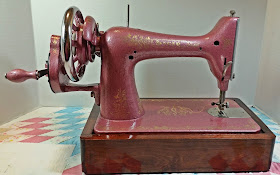Hello, fellow sewing machine fanatics
Eleanor from Sydney, Australia has been working on her Husqvarna in between dealing with her responsibilities as secretary of a lawn bowls organization.
Yep, I had to look up lawn bowls, which I had never heard of. The photos look kind of like bocce ball, but since I have never played that sport either I can't really say. Both seem to involve flinging small wooden balls around. It is winter in sunny Sydney and any outdoor sport sounds good to me about now. Sammie and I had to give up our outdoor walks months ago when the Southern heat and humidity kicked in.
She has been sending me pictures of her progress in repainting a Husqvarna, from crinkle green to hammered copper, and I have finally gotten around to putting them together here. The Husqvarna is shown first. Then at my request she also sent pictures of a lovely 66 repainted a bright blue, so keep reading until you get to that one.
All photos are by Eleanor and all text in quotes is from her emails to me.
Original color
First coat
"As promised, I got started. Very cold here in Sydney (my last excuse to you was that it was too hot!), so, I've rugged up in my thermals and sitting out on my back verandah putting the first coat on. It looks like a dog's breakfast! As you can see, I changed my mind again on colour and have gone the hammered copper route. I think this will suit the machine and if I'm able to work out how to do water slide decals, they'll be black. I've found the font type and the water slide printing paper on eBay, haven't purchased yet. "
"So I got the brushes out again and worked on my bits while the mood struck. The tin says one coat should be sufficient on previously painted metal in sound condition. I guess they hadn't met Godzilla finish, or my need to work quickly around fiddly bits."
Treadle flywheel and pitman
Second coat
"Just sending you some more pics to show that I haven't gone to sleep on you again with it. I've put another coat on today and it is starting to look a whole lot better. I'm very happy now with my colour choice.. It's my first experience with a wooden pitman, so it would be nice to restore it back in its own treadle."Third coat
"I put another coat on today to patch the bits of green that were still persistently showing through. I think I'm nearly there. I must now get the water slide decal paper for our laser printer and start searching for some images."
* * * * * * * * * * * * * * * * * * * *
and if you thought all that was fun, just LOOK at the bright blue Singer 66 she repainted.
"This machine was picked up out of a ditch by my friend's son and sat in her yard for twelve months or so before coming my way. It took me about three months of occasional fiddling to eventually get it turning over. The Lotus decal is the most common 66 pattern seen in Australia and I have three other lovely ones, so felt no guilt in repainting this one."
I sure wish the Lotus decal was that common here in the US. Red Eye is our common pattern. Also lovely but I particularly like the Lotus.
"This is the one with the Indian crank, which you now know all about and I use it a lot."
She is referring to a discussion of hand cranks from India, available in Australia but not here in the US. Notice the two holes in the mounting part. One hole is for Singers the other is for another brand--I think it was Pfaff but don't quote me on that. Notice the nice wooden knob. Notice the metal ring covering the gear (as opposed to the plastic one on the Chinese hand cranks). Notice the all around better look--no rough casting here.
WHY CAN'T WE HAVE THESE HERE? Someone on the board investigated and found it would be cost prohibitive to import them from Australia. But they are from India. Why are our suppliers not importing the Indian version? I will have to do some nudging on this.
"I had been following your blog and missewsitall and thought "what have I got to lose?" My freehand calligraphy could be better, but I don't really mind it"
"The little arrow markings were personal fake tattoos and worked well. I gave it a spray of clear coat too."
Aha, I thought I was the only one who had thought of using the fake tattoos. You will see this again soon on the machine I have decorated for 6 year old Clinton.
Lovely work! Thanks, Eleanor. Looking forward to seeing the finished version of the Husqvarna too.




















































